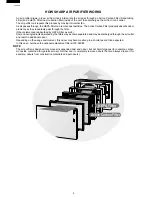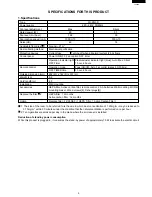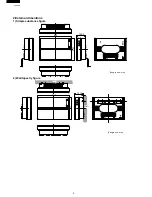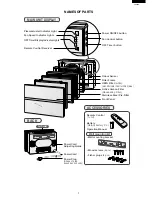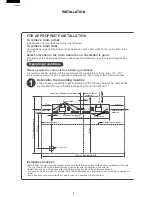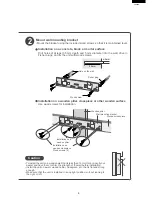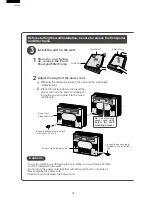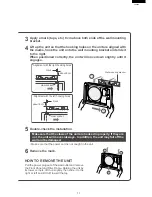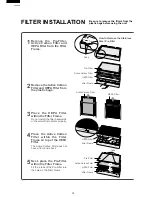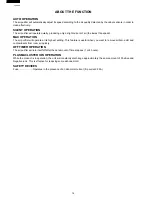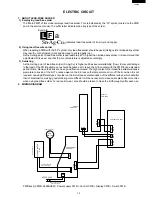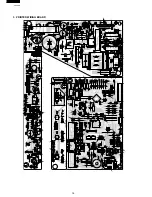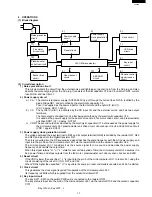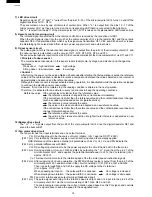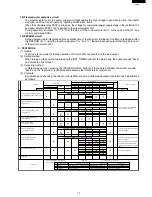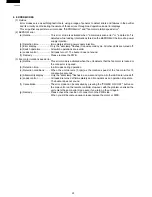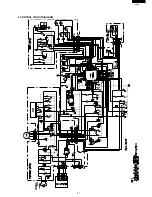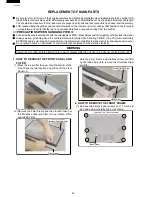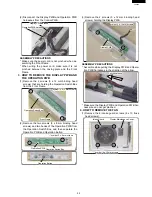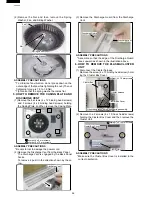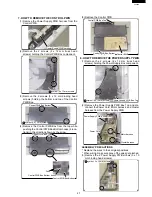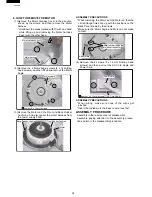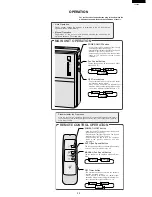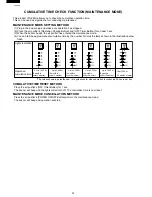
18
FU-28H-S
7) LED drive circuit
Repetitive signal of " H " and " L " output from the pins 18 - 20 of the microcomputer LSI-1 turns on and off the
digital transistors Q110 - Q112.
They are turned on one by one at intervals of certain time. When " L " is output from the pins 15 - 17 of the
microcomputer LSI-1 as they are turned on, the corresponding LED that are connected to them light up.
And " L " is output from the pin 11 of the microcomputer LSI-1, Q113 is turned on, the plasmacluster LED turned on blue.
8) Remote control receiving circuit
The infrared signal transmitted from the remote controller is received by the reception unit RU1.
When the H/L signal is input into the pin 23 of the microcomputer LSI-1 via the resistor R81 and the ceramic
capacitor C83, it is determined from which key the signal was transmitted. C81, C82, and C83 absorb or reduce
the disturbing lights, noise derived from its own power supply circuit, and external noise.
9) Odour sensor circuit
The pulse signal, which is the odour sensor drive signal, is output from the pin 41 of the microcomputer LSI-1, and
the odour sensor is pulse-driven on the circuit of Q71, Q72, R73, R74, R76, and C73.
The sensor output signal is input into the pin 29 (A/D conversion terminal) of the microcomputer LSI-1 via R71 and C71.
< Principle of odour sensor >
The metal oxide semiconductor in this sensor reacts to ammonia, hydrogen, and alcohol, and changes the
resistance.
Weak odour : high resistance
_
high voltage
Strong odour : low resistance
_
low voltage
< Control >
After turning the power on, the value obtained 25 seconds after starting the first operation is set as the reference
value and the contamination is decided in relative comparison between the values detected at an interval of
approximately one second and the reference value.
Although the odour sensor is always activated during operation, it is deactivated while the operation is stopped
to cut down the standby power consumption.
However, if it comes to a complete stop, the reading condition is altered in the next operation.
Therefore, it is activated for one minute in every ten minutes to keep the operating conditions.
Reference value : If the current level is cleaner than the reference value
_
the reference value is changed to the current value immediately.
If the current level is dirtier than the reference value and the contamination level changes
(such as suddenly increased odour of cigarette smoke)
_
the reference value remains the same
_
the value in the clean condition is adopted as a new reference value.
If the current level is dirtier than the reference value and the contamination level does not
change (Natural change only)
_
the reference value remains the same.
_
the value in the cleanest condition at eight-minute intervals is adopted as a new
reference value.
10) Buzzer drive circuit
The " H " / " L " signals output from the pin 22 of the microcomputer LSI-1 drive the digital transistor Q51 and
sound the buzzer BZ1.
11) Fan motor drive circuit
The fan motor has four input terminals and one output terminal.
Vm : DC voltage input to be the source of motor rotation. (Vm = approx. DC311-339V)
(FM 7 pin) Vm created by the power supply circuit is directly input and is constantly applied.
GND : Reference of the electric potential. All potentials such as Vm, Vcc, Vs, and PG indicate the
(FM 5 pin) potential differences with GND.
Vcc : DC voltage input terminal to be the power supply for the circuit that is built in the fan motor.
(FM 3 pin) During operation, it turns on Q43 and Q44 by outputting the " H " signal from the pin 21 of the
microcomputer LSI-1, and supplies the potential almost equal to VL to the Vcc terminal (Vcc =
approx. DC15V).
Vs : This input terminal controls the rotation speed of the fan motor (speed instruction signal).
(FM 2 pin) After supplying Vcc during operation, the PWM (x/256
µ
s) pulse is output from the pin 25 of the
microcomputer LSI-1 and smoothed in the circuit consisting of C41, R41-43, Q41 and Q42.
Then it goes through R46 and C43 to supply the DC voltage to the Vs terminal.
(Vs = approx. DC 0 ~ 6V)
When speeding up rotation
: the pulse width X is widened
_
Vs voltage is increased
When slowing down rotation : the pulse width X is narrowed
_
Vs voltage is decreased
PG : Fan motor rotation speed output terminal (feedback signal)
(FM 1 pin) The pulse signal according to the rotation speed is output and it is input into the pin 24 of the
microcomputer LSI-1 via the circuit consisting of R47, R44, R45, and C42.
The microcomputer recognizes the current rotation speed based on this PG signal, and controls
the Vs signal above to keep the speed to the designated level.
Содержание FU-28H-S
Страница 16: ...16 FU 28H S 3 PRINTED WIRING BOARD ...
Страница 21: ...21 FU 28H S 6 CONTROL CIRCUITDIAGRAM ...

